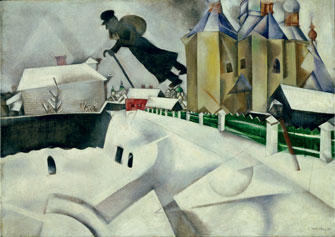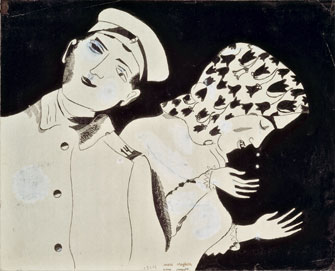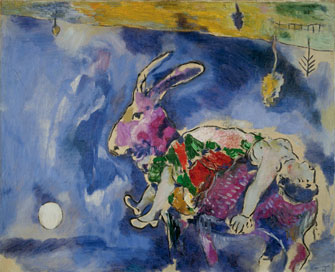Flying in the Face of
Chagall-mania

”Au-dessus de Vitebsk” (1915-20). © ADAGP, Paris 2013/CHAGALL ® © The Museum of Modern Art, New York/Scala, Florence
Like Salvador Dalí, Marc Chagall (1887-1985) is a painter beloved by all, or so it would seem. His popularity is huge, and his work is pretty much universally known and visible everywhere: painted on the ceiling of the Opéra Garnier in Paris and the walls of the Metropolitan Opera in New York, and in stained glass on the UN building in New York, the Cathedral of Reims in France and the Art Institute of Chicago, not to mention the presence of his paintings in museums around the world. Why is he so popular? Perhaps it is the great joy expressed in his paintings, the vivid colors he uses or the childlike whimsy of all those flying animals, brides, bouquets of flowers, etc.
Personally, I have never bought it, although I have tried hard to appreciate his work. The constant repetition of the same symbols, which Chagall himself claimed were not symbols, is annoying, in much the same way that Joan Miró’s constantly repeated figures become clichés when you see many of his paintings together. And, in Chagall’s case, the bright, joyful colors, while often uplifting, seem to be arbitrarily applied.
A visit to the exhibition “Chagall: Entre Guerre et Paix,” which opens today at the Musée du Luxembourg, did not change my mind, even though I found that there is much to admire about Chagall: his seemingly unquenchable high spirits, for example. Although in this exhibition we see his reaction to the historical and personal tragedies he encountered in his nearly hundred years of life – pogroms, two wars and the death of his wife Bella in 1944 – he always seems to bounce back, returning to bright colors after initially reacting with a dark palette.
I also found it interesting that he remained his own artist, mostly withstanding the influence of such major 20th-century art movements as Cubism, Futurism, Supremetism and Surrealism, even though he lived in the thick of them, in Paris between 1911 and ’14, and again between 1923 and ’41, and in Russia, where he was trapped by war, between 1914 and ’22. While the influence of these movements shows up in his work, he was never co-opted by any of them, although he might be termed a “natural Surrealist.”
The two obviously Cubist-influenced paintings in this show, “Le Rabbin de Vitebsk” (1914-22) and “Au-dessus de Vitebsk” (1915-20, pictured above), seemed to me to be among the most accomplished in terms of both composition and painting. Chagall’s usual painting style strikes me as awkward and sometimes inept, as if he were pretending to be a naïve painter.
The show starts with a charmingly awkward 1914 self-portrait, “Autoportrait devant la Maison,” accompanied by the intriguingly distorted and powerful “Les Amoureux en Vert” (1916-17), in which the head of a man with his eyes closed rests on the chest of a

“Les Amoureux en Vert” (1916-17). © ADAGP, Paris 2013/CHAGALL ® © RMN/Gérard Blot
woman in a red dress; as rigid as a doll, she stares straight ahead into space. They are seen in profile against a green background. This early, simpler style makes you wish he had continued in this vein.
His drawings are another surprise. When Chagall simplifies his compositions and does

“Couple de Paysans, Départ pour la Guerre” (1914). © ADAGP, Paris 2013/CHAGALL ® © Centre Pompidou, MNAM-CCI, Dist. RMN/Philippe Migeat
without color, as in the very strong drawings of refugees and wounded soldiers in the exhibition, his work is far more affecting, to my eye, than those often overblown, belabored paintings teeming with figures and clashing colors that fill the rest of the show.
Another argument in favor of simplicity is the less cluttered “Songe d’une Nuit d’Éte” (1939), with only two main figures – a donkey-headed man (the Bottom character from Shakespeare’s play) embracing his bride – and two tiny figures floating in the background. The color is handled more effectively in this painting as well.
I also liked another atypical painting hanging near it, the surrealistic “Le Rêve” (1927), which

“Le Rêve” (1927). © ADAGP, Paris 2013/CHAGALL ® © Musée d’Art Moderne/Roger-Viollet
shows a large rabbit in an upside-down landscape, with a naked woman splayed face up over its back.
In fact, it turns out that all the individual works that impressed me in this show were the atypical ones. Am I a minority of one?
Musée du Luxembourg: 19, rue de Vaugirard, 75006 Paris. Métro: Saint-Sulpice or Odéon. RER: Luxembourg. Tel.: 01 40 13 62 00. Open daily 10am-7:30pm, until 10pm on Friday. Closed May 1. Admission: €11. Through July 21, 2013. www.museeduluxembourg.fr
Reader Steven Kolpan writes: “I enjoyed your Chagall review; quite insightful. I, too, am not much of a fan of what always seemed like his forced happiness, his phony optimism, the grand gesture, his self-denied symbolism.”
Reader Barney Kirchhoff writes: “Yes. I choked on Chagall many years ago.”
Reader Owen McGowan writes: “I agree ever so about Chagall, a major muralist but no painter. Not a fraud like Dalí, just not the bee’s knees.”
Reader Tony Smith writes: “Amazing! I thought I was the only person who doesn’t like Chagall. In fact, I hold a grudge against him. To me, his work seems to be without content, forced and unnatural. Yet he is everywhere.”
Reader James Helgeson writes: “Yes! Excellent review. I also have always found Chagall cloying. There are a couple of lovely paintings, though: recently I saw a 1920s view out of a window that avoids the usual clichés and maudlin pathos. It’s just a lovely study in greens.”
Reader reaction: Click here to respond to this article (your response may be published on this page and is subject to editing).
Please support Paris Update by ordering books from Paris Update’s Amazon store at no extra cost. Click on your preferred Amazon location: U.K., France, U.S.
More reviews of Paris art shows.
© 2013 Paris Update
